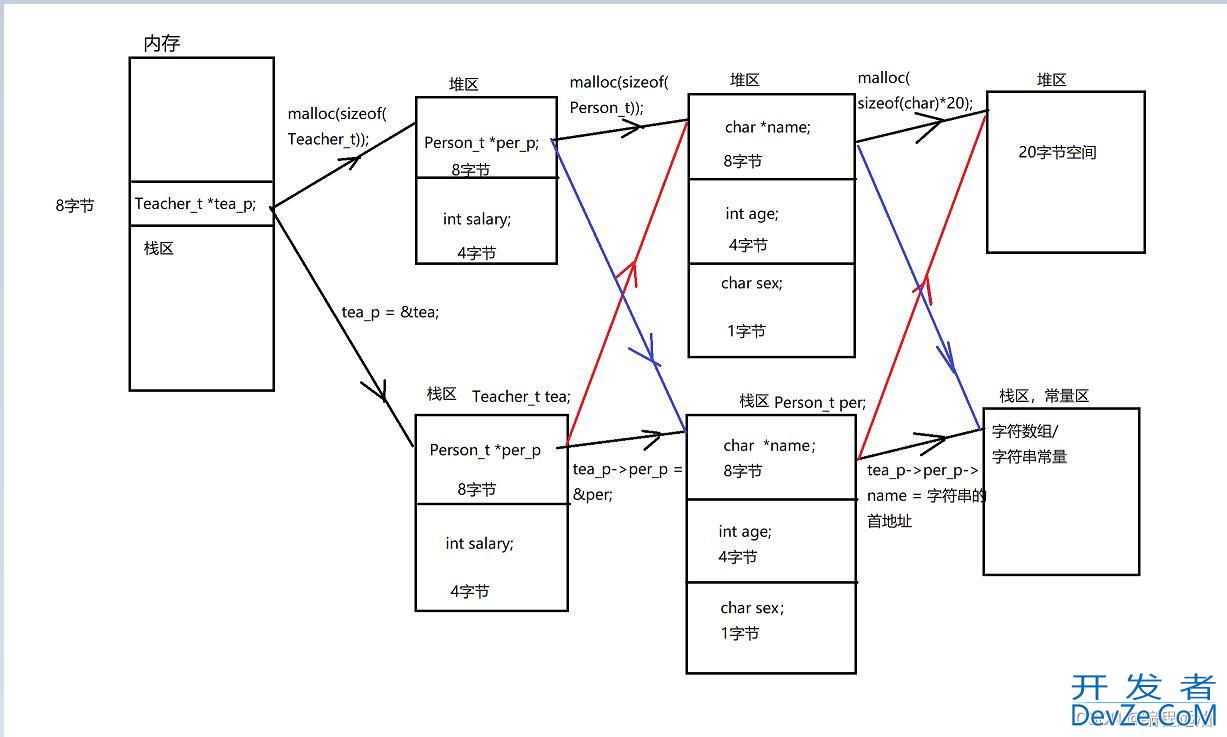C语言结构体嵌套与对齐超详细讲解
目录
- 嵌套结构体
- 结构体内存对齐
- 32位的操作系统
- 64位的操作系统
嵌套结构体
格式:
typedef struct 结构体名 {struct 结构体名1 结构体变量名1;struct 结构体名2 *结构体指针变量名1;}结构体别名_t;
定义结构体普通的变量,访问结构体中的成员:
结构体别名_t 普通结构体变量名;
普通结构体变量名.结构体变量名1.成员名;
普通结构体变量名.结构体指针变量名1->成员名;
定义结构体指针变量,访问结构体中的成员
结构体别名_t *结构体指针变量名;
结构体指针变量名->结构体变量名1.成员名;
结构体指针变量名->结构体指针变量名1->成javascript员名;
总结,访问结构体中的成员时,具体使用.还是->,需要看当前的结构体变量的类型。
测试用例:
#include <stdio.h>
#include <string.h>
#include <stdlib.h>
typedef struct Person
{
char *name;
int age;
char sex;
} Person_t;
typedef struct Student
{
Person_t per;
int score;
} Student_t;
typedef struct Teacher
{
Person_t *per_p;
int salary;
} Teacher_t;
int main(int argc, const char *argv[])
{
/*your code*/
// 1. 定义结构体类型的变量
Student_t stu1;
// 2. 初始化结构体中的成员
stu1.per.name = (char *)malloc(sizeof(char) * 20);
if (stu1.per.name == NULL)
{
printf("malloc failed\n");
return -1;
}
strcpyyhIqT(stu1.per.name, "zhoukai");
stu1.per.age = 18;
stu1.per.sex = 'M';
stu1.score = 99;
printf("姓名:%s 年龄:%d 性别:%c 工资:%d\n",\
stu1.per.name, stu1.per.age, stu1.per.sex, stu1.score);
// 使用Teacher_t定义结构体指针类型的变量,使用malloc分配空间
Teacher_t *t=(Teacher_t *)malloc(sizeof(Teacher_t));
if(NULL==t)printf("malloc memory filed!\n");
// 对Teacher_t类型中的per_p成员,使用malloc分配空间,
t->per_p =(Person_t *)malloc(sizeof(Person_t));
if(NULL==t->per_p)
{
printf("malloc memory filed!\n");
return -1;
}
// 对Person_t中的name成员,使用malloc分配空间。
t->per_p->name=(char *)malloc(sizeof(char)*20);
if(NULL==t->per_p->name)
{
printf("malloc memory filed!\n");
return -1;
}
// 分配堆区空间时,从外向内进行分配;释放空间时,从内向外分配空间。
strcpy(t->per_p->name,"yao");
t->per_p->age=10;
t->per_p->sex='M';
t->salary=100000;
printf("姓名:%s 年龄:%d 性别:%c 工资:%d\n",\
t->per_p->name,t->per_p->age, t->per_p->sex,t->salary);
//释放空间
free(t->per_p->name);
t->per_p->name=NULL;
free(t->per_p);
t->per_p=NULL;
free(t);
t=NULL;
return 0;
}
图解:

结构体内存对齐
32位的操作系统
结构体中成员内存对齐,只考虑基本的数据类型,不考虑构造类型,构造类型最终也是由基本类型构成。
1> 如果结构体中的成员最大的成员只占1个字节的空间,则结构体类型的大小为1的整数倍;2> 如果结构体中的成员最大的成员只占2个字节的空间,则结构体类型的大小为2的整数倍;3> 如果结构体中的成员最大的成员只占4/8个字节的空间,则结构体类型的大小为4的整数倍;结构体中的成员的地址:1> 如果结构体中的成员为char类型,此成员的地址是1的整数倍;2> 如果结构体中的成员为short类型,此成员的地址是2的整数倍;3> 如果结构体中的成员为int,long int, long long int, float, double 类型,此成员的地址是4的整数倍;编译成32位的可执行程序:
gcc ***.c -m32
测试:
#include <stdio.h>
#include <string.h>
#include <stdlib.h>
//1> 如果结构体中的成员最大的成员只占1个字节的空间,则结构体类型的大小为1的整数倍;
typedef struct{
char name[20];
char sex;
char age;
}A_t;
//2> 如果结构体中的成员最大的成员只占2个字节的空间,则结构体类型的大小为2的整数倍;
typedef struct{
char name[20];
short age;
char sex;
// 保留一个字节
}B_t;
typedef struct{
char name[20];
char sex;
// 保留一个字节
short age;
}C_t;
//3> 如果结构体中的成员最大的成员只占4/8个字节的空间,则结构体类型的大小为4的整数倍;
typedef struct{
char name[20];
char sex;
// 保留三个字节
int age;
}D_t;
typedef struct{
char name[20];
char sex;
// 保留一个字节
short score;
int age;
}E_t;
typedef struct{
char name[20];
char sex;
// 保留一个字节
short score;
long long int age;
}F_t;
typedef struct{
char *name;
char sex;
// 保留一个字节
short score;
long long int age;
}G_t;
typedef struct{
char *name;
char sex;
// 保留一个字节(不同类型的在同一行,不同的那个从后往前补!!!)
short score;
char salary;
long long int age;
}H_t;
int main(int argc, const char *argv[])
{
/*your code*/
printf("A_t type size=%d\n",sizeof(A_t));//22
printf("B_t type size=%d\n",sizeof(B_t));//24
printf("C_t type size=%d\n",sizeof(C_t));//24
printf("D_t type size=%d\n",sizeof(D_t));//28
printf("E_t type size=%d\n",sizeof(E_t));//28
printf("F_t type size=%d\n",sizeof(F_t));//32
printf("G_t type size=%d\n",sizeof(G_t));//16
printf("H_t type size=%d\n",sizeof(H_t));//20
printf("-----------G_t中成员的地址-----------\n");
G_t g;
printf("G_t成员 char *name 的地址%p\n",g.name);
printf("G_t成员 char jssex 的地址%p\n",&g.sex);
printf("G_t成员 short score 的地址%p\n",&g.score);
printf("G_t成员 long long int age 的地址%p\n",&g.age);
printf("-----------H_t中成员的地址-----------\n");
H_t h;
printf("H_t成员 char *name 的地址%p\n",h.name);
printf("H_t成员 char sex 的地址%p\n",&h.sex);
printf("H_t成员 short score 的地址%p\n",&h.score);
printf("H_t成员 char salary 的地址%p\n",&h.salary);
printf("H_t成员 long long int age 的地址%p\n",&h.age);
return 0;
}
64位的操作系统
结构体中成员内存对齐,只考虑基本的数开发者_JAVA开发据类型,不考虑构造类型,构造类型最终也是由基本类型构成。
1> 如果结构体中的成员最大的成员只占1个字节的空间,则结构体类型的大小为1的整数倍;2> 如果结构体中的成员最大的成员只占2个字节的空间,则结构体类型的大小为2的整数倍;3> 如果结构体中的成员最大的成员只占4个字节的空间,则结构体类型的大小为4的整数倍;4> 如果结构体中的成员最大的成员只占8个字节的空间,则结构体类型php的大小为8的整数倍;结构体中的成员的地址:1> 如果结构体中的成员为char类型,此成员的地址是1的整数倍;2> 如果结构体中的成员为short类型,此成员的地址是2的整数倍;3> 如果结构体中的成员为int,float类型,此成员的地址是4的整数倍;4> 如果结构体中的成员为long int, long http://www.devze.comlong int, double 类型,此成员的地址是8的整数倍;编译成64位的可执行程序:8的整数倍;结构体中的成员的地址:
1> 如果结构体中的成员为char类型,此成员的地址是1的整数倍;2> 如果结构体中的成员为short类型,此成员的地址是2的整数倍;3> 如果结构体中的成员为int,float类型,此成员的地址是4的整数倍;4> 如果结构体中的成员为long int, long long int, double 类型,此成员的地址是8的整数倍;编译成64位的可执行程序:gcc ***.c到此这篇关于C语言结构体嵌套与对齐超详细讲解的文章就介绍到这了,更多相关C语言结构体嵌套内容请搜索我们以前的文章或继续浏览下面的相关文章希望大家以后多多支持我们!






 加载中,请稍侯......
加载中,请稍侯......
精彩评论